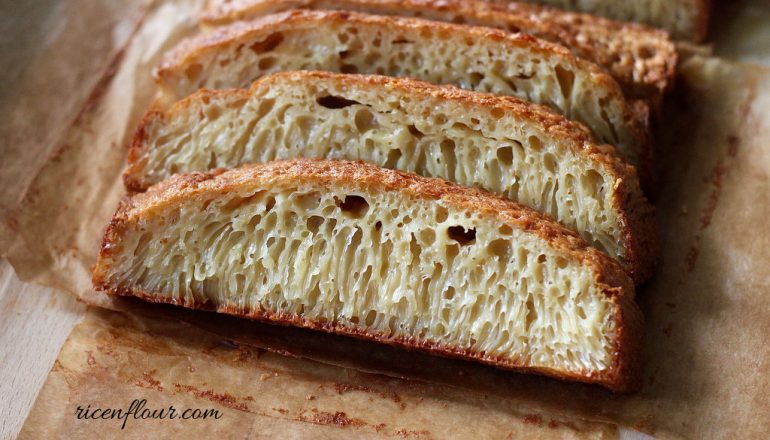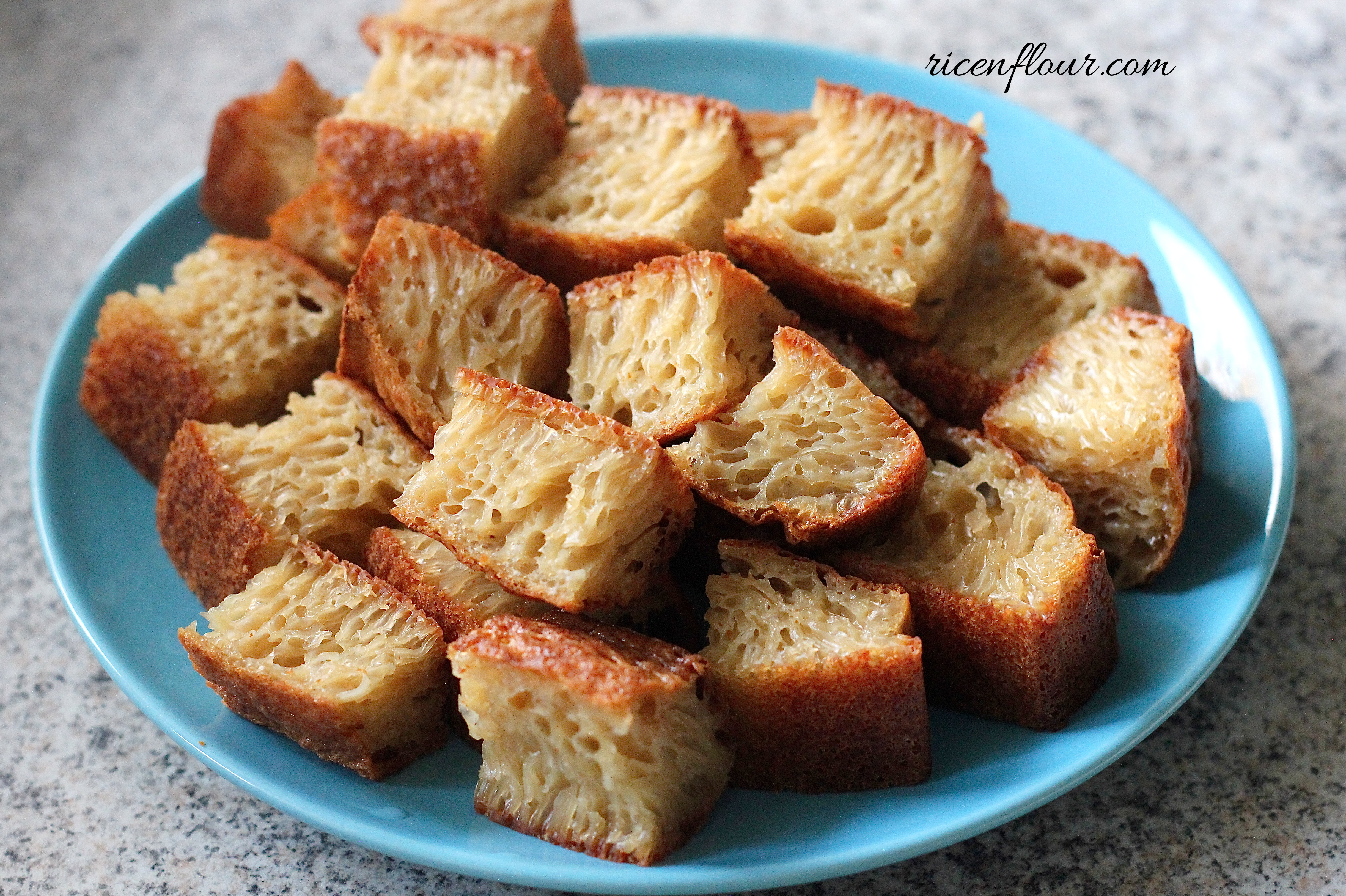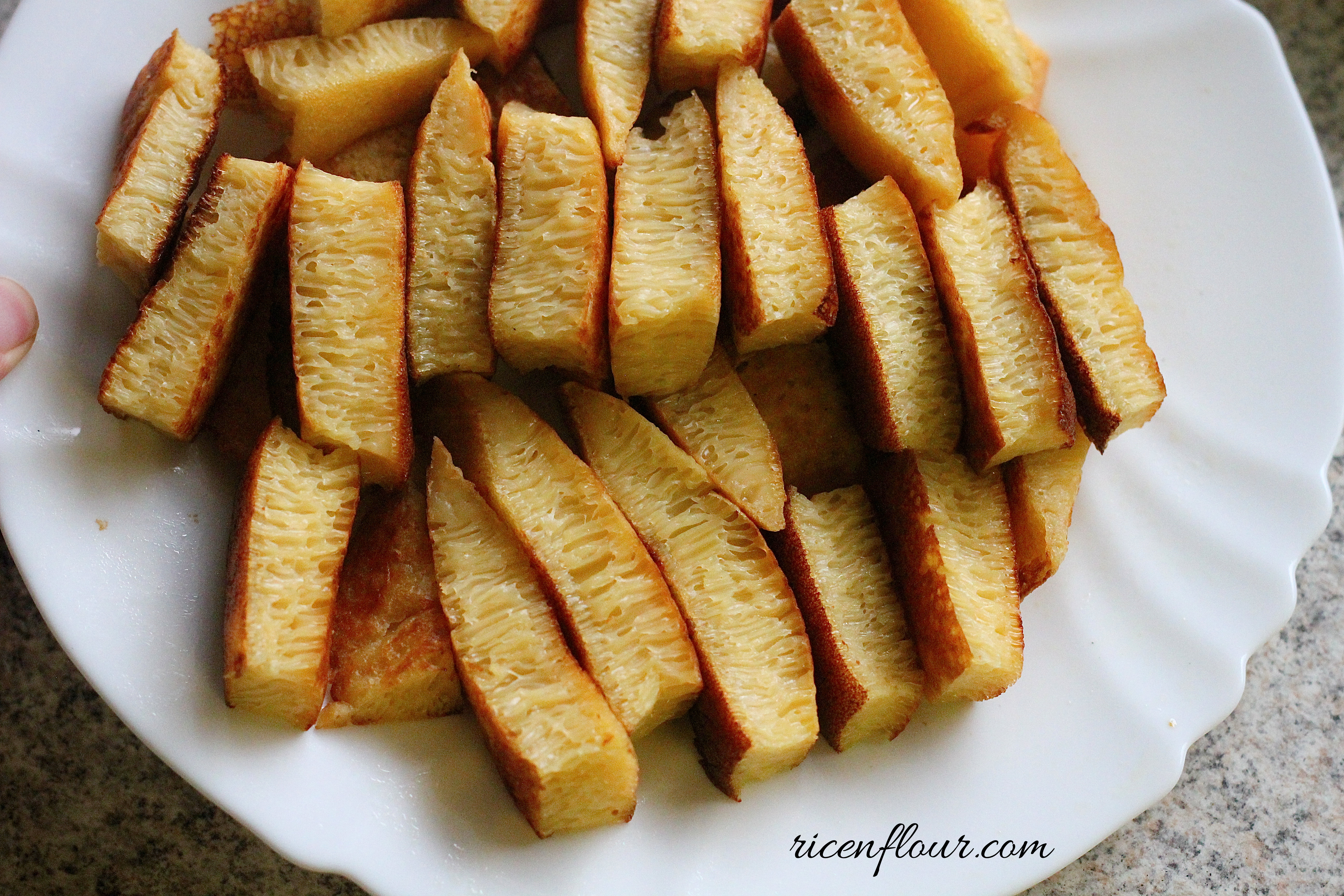Bánh bò (Vietnamese honeycomb cake) is a type of sweet and chewy sponge cake from Vietnam, and a relative of Indonesian bika ambon or Malaysian honeycomb cake (kek sarang semut) (click on the link for the recipe). You don’t eat bánh bò by immediately biting into it, because the cake is very chewy and rather leathery, but by tearing the squishy cake into small bite-size pieces. Once you break into bánh bò, you will start to see the cake’s interior with many holes and air pockets – that’s why bánh bò is sometimes known as beehive cake, or ants’ nest cake.
The name ‘bánh bò’ fascinated me as a child. In Vietnamese, ‘bánh’ means cake, and ‘bò’ can either mean the verb ‘crawl’ or the noun ‘cow’ depending on the context, so I would always wonder how the cake comes to have that name: it definitely cannot move around, and the sweet coconuty taste of the cake certainly does not seem at all like beef. My mom used to explain, from an old folk saying, that ‘bánh bò’ means ‘crawling cake’, because when you let the cake proof, the batter will slowly rise and ‘crawl’ up the side of the bowl.
Bánh bò is often served on its own, and it is perfect for a light afternoon tea, or a fun after school treat for children. When I first found out and experimented making this cake, I was so surprised by how easy it was to recreate one of my favourite childhood cakes at home: simply mix a few ingredients, wait for the batter to rest, and then bake the cake and wait for it to be ready. You can either make this in the oven, or fry the cake on the pan. The texture of the pan-fried version is a bit similar to crumpets, so do try out this recipe for a breakfast with a twist as well!
How to Make Vietnamese Honeycomb Cake (recipe)
INGREDIENTS
- 150 grams coconut milk
- 75 grams palm sugar – you can also substitute with brown sugar or golden caster sugar
- 100 grams tapioca starch
- ½ tsp (2 grams) instant yeast – instant yeast doesn’t need to be activated in warm water like active dry yeast – you can certainly substitute instant yeast with other kinds of yeast by following the package of your yeast to work out the correct amount.
- 3 large eggs (60 grams/egg)
* Note:
- You can buy canned coconut milk, or fresh one is even better. Coconut milk is not the same as coconut cream, check out the link to our glossary to make sure you know what is the difference.
- Palm sugar (click on the link to see our glossary) has a milder and lighter sweetness than regular white sugar, if you cannot find palm sugar, brown sugar is also an adequate substitute, as it brings a light toffee flavour to the dish. You can adjust the amount of sugar to taste.
- Vanilla extract or pandan extract can also be added to the batter. Indonesian bika ambon is usually flavoured with lime leaves or lemongrass.
VIDEO INSTRUCTION
A detailed recipe with all the specific notes is available on my YouTube Channel (Savoury Days Kitchen) in both English and Vietnamese (select your preferred language by clicking CC > Setting > Language). You guys can check it out at this link or the video right below.
PRINTABLE RECIPE
1. Put the coconut milk and sugar into a pot. Put the pot on high heat and stir constantly to dissolve the sugar. When the sugar is incorporated into the coconut milk, put the pot off the heat and leave it to cool down to about 35 – 40°C. The mixture should be quite warm to the touch – this is the ideal temperature for the yeast to work its ‘magic’, if the mixture is too hot it will kill the yeast.
2. In a big bowl, add tapioca starch and the yeast, and whisk together. Then add the eggs and beat until the flour and the eggs are incorporated.
3. Pour the warm sweetened coconut milk into the bowl, mix well until the batter is smooth.
4. Cover the bowl with a tea towel or cling film. Leave the batter to rest in a warm place (30 – 35 °C) for about 2 – 2.5 hours, until the batter has risen and there is a layer of foam on the top layer of the batter.
If your kitchen is rather cold, you can leave your batter to rest in a warm oven (turn the oven to 100°C, leave it on for 45 – 60 seconds and switch it off to create a warm but not too hot environment), or place the bowl into a large pot of warm water. The temperature in which the batter is rested should be around 30 – 35°C, if it is hotter it might kill the yeast.
5. Gently stir the batter to incorporate all the ingredients again. Make sure to scrape the bottom of the bowl as the flour usually sinks after resting, but don’t stir too vigorously to avoid breaking the air bubbles.
6. At this stage, you can either bake the cake in the oven or pan fry it. Frying takes less time than baking, but you need to constantly be on watch. Here is instruction for both methods so that you can choose whatever you fancy
* Option 1: Oven Bake
– Preheat the oven at 180°C / 356°F, top and bottom heat. Butter your cake tin and line it with greaseproof paper (see the video for a more detailed visual instruction).
– Pour the batter into the tin. Put the tin in the lowest rack of the oven. Bake the cake at 170 – 175°C / 338 – 347°F in about 40 – 45 minutes until the cake turns golden brown and the skewer poked in the middle of the cake comes out clean.
Important note:
– The temperature of your oven can vary, you should adjust the heat according to the state of your cake. If the cake rises very quickly and then deflates, the temperature might be too high. If the cake takes a long time to rise and the flour sinks to the bottom of the cake, the temperature might be too low for the baking time.
– For bánh bò, it’s better to bake the cake a little bit over time rather than undercooking it. The most important thing for bánh bò is the airy and squishy texture, which takes time to develop. If the surface of the cake turns brown too quickly, you can cover the tin with a piece of foil.
* Option 2: Pan Fry
– On medium heat, preheat a non-stick pan. The pan should ideally have a flat bottom, 12 – 20 cm wide and comes with a lid.
– Melt about ½ tsp coconut oil or cooking oil in the pan. Spoon some batter into the pan, about 0.5 – 1 cm thick. Cover the pan and keep it on medium low heat for 3 – 5 minutes, depending on the thickness of the cake.
– When the top side of the cake is dry, flip the cake over. Fry for about another minute and take the cake out onto a plate and leave to cool.
Important note:
- It’s best to leave the stove on medium to medium-low heat, so that you don’t burn the bottom of the cake while still allowing enough heat to cook the cake properly.
- Don’t forget to stir the batter gently in between each frying cake, to ensure all the ingredients are incorporated.
7. Serve:
Bánh bò is best served fresh within the day. You can keep the cake in an airtight container if you make a large batch, but the cake would taste less fresh and squishy on the next days.
- Recipe by: Linh Trang
- Written by: Thao Dan






JOIN US